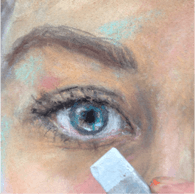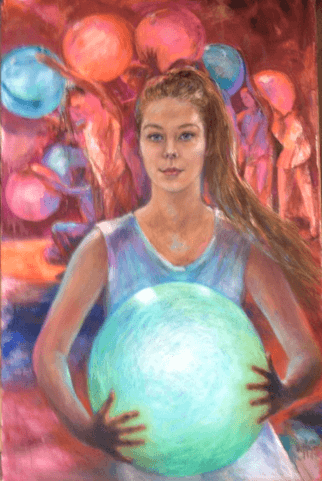I have set myself the goal of submitting an entry into the Archibald Prize annually for at least five years. This is my fourth entry. It helps if the sitter is well known but it isn’t a rule of entry, just a suggestion. I don’t know anyone who would constitute a well known person for the Archibald prize and I am a little shy of asking someone “famous”, who I don’t know, to sit for me- I’m working up to that one.
Janet Hayes Mixed Media Portrait
So, in thinking about my entry for this year I asked myself the question “What do I want to be known for?” And this image immediately popped into my head. It’s my daughter, Tahlia, dancing with her Yellow Wheel contemporary youth company at White Night, Melbourne 2015- they performed an amazing contemporary piece called DNA, performing with large spheres that lit up, which could turn off and on and change colour by touch, challenging to move with. The dancers and choreography were charged with high energy- it looked spectacular. I wanted to get that feel into the artwork. Tahlia herself is so totally present when she dances and she has this way of creating movement through her whole body and I wanted to portray both those elements in the portrait hence she looks directly and intently.
In the initial sketch I just wanted to indicate placement of the figure, with an emphasis on the head without concerning myself with a likeness at this stage and an impression of the background.
Developing the portrait
I then start developing the position of the body, the background and the face more. The background I’m working uses some photos and a video I took of the performance, the face I work solely from life, as is my preference. I use charcoal on a sheet of Arches printmaking paper 130x80cm which I cut from a roll. I want this portrait to be larger than life
Developing the face
I start with charcoal, concentrating on proportions, I know Tahlia’s face so well that the drawing comes together easily, the challenge is fitting the lighting of the studio with the stage background.
I still haven’t progressed the background in the next image as I have a small window of opportunity- a short session with my model to work from life to add colour and tone to the face. The portrait changes- different expression- the shape of the eyebrows can change so much, I sort of like the immediacy of the image at this stage, really tempting to just leave it, however, I am working towards the image I saw in my mind’s eye so I push on.
I work over my charcoal drawing with acrylic paint (and I forget to photograph the background, although it doesn’t change that much in the final stage except for a bit of definition with pastel). I work another layer of pastel and loose the likeness, but I’m not concerned; the positive is I’ve built up more colour and form in the face. I take a break away from it so that I can be objective enough to realise the eyes are too small in the face for Tahlia, the shadow areas around the eyes and nose too dark and the width of the face has “grown”.
I add more pastel colour to the background and “trim” the face, working on this layer I get back some of the likeness, although I know I have made Tahlia look older and the expression is not quite right; a little reserved -not “present” and “pleasant” enough for Tahlia.
Another break, another session from life and I know I need to soften the tonal transitions, soften the features and hairline, round shapes a little more and pay closer attention to what is happening with the eyes. I love all the stages of working on a portrait, but this I particularly love: in the image at right you can see how close in colour and tone that pastel is to what I have already put down (the beauty of working in pastel is being able to pick up the exact same colour or a just that perfect, slightly different colour or tone) using a delicate touch is like gently touching skin rather than just pastel on paper- it feels magical.
Close to the finish, Tahlia is starting to get a little over posing, but I really want to capture life so it’s really important for me to work from life, particularly the finishing touches.
At this stage I really need to work out which light source needs to dominate and choose to enhance the beautiful light on her left cheek (on the right as you look at the artwork).
It’s a challenge knowing when to stop, but I still am not completely happy so, after this, I soften the lips and around the eyes ever so slightly and decide to call it a day, I’m pressured to put it into it’s frame and deliver it to the courier to make its journey to Sydney on time.
Outcome
I didn’t get accepted into the a Archibald Prize finals this year. Yeah, it is a bit disappointing, but the joy of working on this painting, capturing that wonderful energy of Yellow Wheel’s piece and a special moment in my daughter’s (and my) life, far outweighs that. I’m finding that these challenges I set myself avail me of experiences I wouldn’t have otherwise had.
Download full article and images (pdf)
Janet Hayes, Artist
Pastels, Portraits, Classes
www.janethayes.com.au
Pastel tip
Pastel portraiture – eye whites
 One of the challenges of portraiture is creating an ‘alive’ eye. Most people think that the white of the eye is pure white, yet, if you were to wear white pancake or clown makeup on your skin you would see that the white of the eye looks either a faint blue grey or a pale yellowish colour. If you were to use a pure white for the eye whites you would create more contrast than what is there creating an unnatural stare and an area of flat, lifeless colour. I generally use a light blue grey, particularly for young, healthy eyes (have you ever notice a faint bluish tinge in your eyes after a day at the beach?) and a raw umber for more mature eyes- although I always try to use what I actually see before me.
One of the challenges of portraiture is creating an ‘alive’ eye. Most people think that the white of the eye is pure white, yet, if you were to wear white pancake or clown makeup on your skin you would see that the white of the eye looks either a faint blue grey or a pale yellowish colour. If you were to use a pure white for the eye whites you would create more contrast than what is there creating an unnatural stare and an area of flat, lifeless colour. I generally use a light blue grey, particularly for young, healthy eyes (have you ever notice a faint bluish tinge in your eyes after a day at the beach?) and a raw umber for more mature eyes- although I always try to use what I actually see before me.
